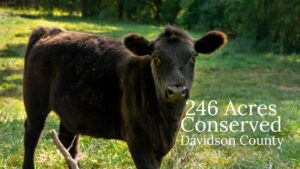
by Philippa Tanford, LandTrust intern summer 2015
July 16, 2015

“Wow!” “If you look at his legs – oh my gosh, that’s so cool.” Several teenagers admire a spiky, strikingly-patterned caterpillar off a trail in Uwharrie National Forest. Anchored by its rear legs, the rest of the caterpillar’s body is moving freely in slow, acrobatic sweeps, as if searching for another perch. It is beautifully patterned, reminiscent of a sea cucumber. “That’s really neat.”
These teens are a part of The Young Naturalists Club based in Raleigh, the brainchild of North Carolina Museum of Natural Sciences ornithologist and curator John Gerwin in collaboration with the Wake Audubon Society, and as The LandTrust for Central North Carolina’s Environmental Education intern I got to spend time with them. At its core, the Young Naturalists Club does an outing once a month, but with enthusiastic members the club has expanded to include more activities and excursions like this nearly week-long Uwharries trip filled with camping, nature journaling, hiking, and hands-on experience with field research methods.
With his expertise as a naturalist and a love for teaching, this program was a long time in the making for John. He was inspired by his childhood participation in a similar program through the Cincinnati Zoo. It developed his appreciation for nature and set him on his career path, and he wanted to provide that kind of experience for others.
One part of that experience in the Uwharries trip is mist netting, a common scientific research tool in which a fine, difficult-to-see net is strung between two poles much like a volleyball net. Birds that fly into the net typically get entangled, and can be carefully extricated for study. (With an experienced researcher like John, this has little effect on the birds’ wellbeing.) Not only do the Young Naturalists directly observe how the bird is handled and assist in attaching leg bands and collecting data, but they also learn how to set up the mist nets on their own. They deal with the logistical considerations of setting up the nets, including staking the poles into the ground, keeping the nets untangled, and finding an area with ideal lighting and topography. They fit some of the birds with radio telemetry transmitters, and the Young Naturalists learn to operate a receiver and antenna to locate the birds in the field and track their movements.

In doing all of this, the Young Naturalists begin to understand what a real research project could look like. They consider the scientific questions they might ask to launch a project, anticipate problems, and visualize what research methods require on a practical level. “By the middle of the trip they are literally spitting out all these ideas,” says John. And though they are always connected to John by a walkie-talkie for safety, after learning the basics they get to work through the process of each task themselves. They discover things on their own and learn how to think scientifically.

And though they all seem to enjoy these activities, they do not forget to have some traditional fun as well. They make s’mores, wade around in the Uwharrie River, tell stories, stop to admire interesting creatures, and do not follow a set schedule. They take a step back from some of the structure and pressure they may face in school or other activities and enter an environment where they have so much fun they may not even realize they are learning.
The Young Naturalists are all really impressive, and spending time with them has been one of the highlights of my time with The LandTrust. They are smart, engaged, excited about the natural world and have good attitudes and diverse interests.
And like John before them, they want to pursue careers in science.